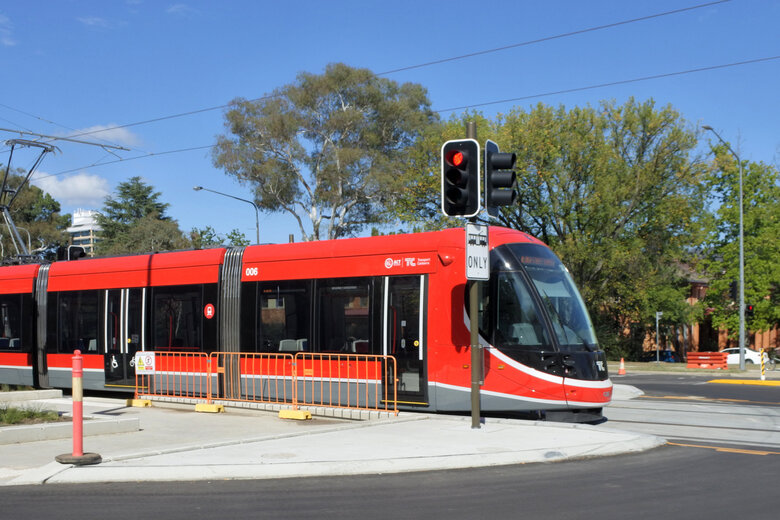
A report has dumped on plans to extend Canberra’s light rail system, saying it’s the wrong solution to the national capital’s public transport problems.

The costs of ongoing work to extend the network are so excessive that they could affect the future financial position of the ACT, according to the report, which is authored by a team of experts including academics and senior public sector figures with expertise in urban planning, transport logistics, and economics.
The initial 12km light rail line linking Gungahlin in the north to the city centre was built after the 2012 ACT election despite analysis showing a Bus Rapid Transit (BRT) system would have been cheaper and better, the authors say.
An extension of the line to Woden is currently being planned in two stages. Stage 2A will go to Commonwealth Park and stage B will go to Woden.
But the report argues that the ACT is being locked into a rigid, inflexible and expensive public transport system that is unsuited to its topography.
“There is simply no justification for the ACT Government to be spending massive amounts of money on Light Rail Stage 2A and 2B, to service less than 10 per cent of Canberra’s commuting public,” it says.
Cost blowouts
The authors say the report comes in response to grave concerns about Canberra’s public transport future and the financial position of the ACT “due to the excessive and disproportionate amount of money” being spent on the light rail project.
The continuing expenditure on Light Rail Stage 2A will only add to the Territory’s growing debt and increasing interest charges, the report says, as well as diverting money from public services like housing, schools, police, womens refuges and roads.
Light rail is an expensive approach to meeting Canberra’s public transport needs. It is inflexible and services only a small percentage of the commuting population. Other options can offer fast, flexible services at lower cost than light rail.
Report: 21st Century Public Transport Solutions for Canberra
The cost of Stage 2A of the light rail has blown out from $268 million in 2019 to more than $1.2 billion, the report says, and Stage 2B is also likely to top $1 billion with ‘negative’ net benefits and major engineering challenges, including navigating around Parliament House.
Instead of proceeding with the light rail, the ACT should be looking at an integrated system comprising EVs, BRT, trackless trams and high occupancy vehicle lanes, the authors recommend.
Industry peak disagrees
However the project has the backing of the nation’s peak rail industry body, which argues the claims made in the report don’t take into consideration the significant long-term economic benefits of light rail, as well as providing an efficient public transport solution.
“Light rail projects in Australia and across the globe have consistently shown to dramatically transform communities, driving urban renewal and growth along its corridor, supporting better housing and job opportunities,” Australasian Railway Association (ARA) CEO Caroline Wilkie says says.
“Furthermore, light rail will greatly contribute to Canberra’s journey to net zero emissions and offers an accessible, safe, easy-to-use transport solution.”
And while light rail might be more expensive to construct than introducing a new bus route, operationally it is comparatively cheaper to run than other modes, she said.
Comment below to have your say on this story.
If you have a news story or tip-off, get in touch at editorial@governmentnews.com.au.
Sign up to the Government News newsletter
This problem has been solved years ago. Somehow the ACT didn’t get the memo. ARRT (aka trackless trams) are widely used and proven, and are a fraction of the cost of a tracked system.
ACT Stops on public transport again?
Sadly the alternative solutions all have a escalating infrastructure cost. and an operational cost, with doubtful long-term benefits.
There is no magic bullets – but there are workable methods to reign in project costs.
Time to Change the mindset and savings can be made
One can reduce the overall cost by stop doing it the crazy Australian way of building public infrastructure:
1.Stop stalling on doing the complete projects,
2. End stopping and starting. as the setup costs alone are huge.
3. Planning for the whole competed project,
so, you can come up with working alternatives to save costs.
I read with humour at what Caroline Wilkie commented on. The only thing that the light rail system has done for Canberra as a whole is helped those living in the Northbourne corridor, and even then I get off a bus each morning at Civic, look across, and see the crowds of people getting off a single tram line like sardines (aka New York or Tokyo). It’s not made things easier for people, just crammed them in more, because there is no alternative service down that route anymore.
Add to that, the latest “upgrades” for the next phase. I’ve already noticed the costs blow out by the ACT Goverment for that. First hint was a one off upgrade to my increased sized rubbish bin, now it’s a yearly charge, did I mention the massive increase of rates over the last ten years, which should have covered that anyway? And signs, footpaths and curbs are being neglected, or if footpaths do need repairing, it’s a quick fix with a splash of bitumen only.